Joining of Hypereutectic Al-50Si Alloys Using Lead-Free Brazing Filler Glass in Air
Abstract
1. Introduction
2. Materials and Methods
2.1. Materials Preparation and Joining Procedures
2.2. Characterization Methods
3. Results and Discussion
3.1. Thermophysical Properties of Brazing Filler Glass
3.2. Effect of Brazing Temperature on Joint Microstructure
3.3. Effect of Brazing Time on Joint Microstructure
3.4. Shear Strength Test of Brazing Joints
4. Conclusions
- (1)
- The coefficient of thermal expansion of the brazing filler glass was ~10.7 × 10−6/°C, which was similar to the value 11.5 × 10−6/°C of used hypereutectic Al-50Si alloys. The matching of thermal expansion coefficient between brazing filler glass and hypereutectic Al-50Si alloys was beneficial for reducing joint stress and improving the joining quality. The glass transition temperature Tg was in a range of 343–350 °C and softening temperature Tf was in a range of 393.2–398 °C. Keeping a holding time of 30 min as a constant, the wetting angle of brazing filler glass on pre-oxidized hypereutectic Al-50Si alloys gradually decreased from 73° to 59° when the temperature changed from 495 °C to 555 °C.
- (2)
- Using Bi2O3-ZnO-B2O3 system brazing filler glass could achieve the joining of hypereutectic Al-50Si alloys. Brazing temperature and time had significant effects on joint microstructure. The rational brazing joint was obtained at brazing temperature of 495 °C for 30 min. The joint could reach the maximum shear strength of 34.49 MPa and a lower air tightness leakage rate of 1.0 × 10−10 Pa m3/s. The air tightness can meet the requirements of modern electronic packaging, which is essential for electronic devices, especially in T/R modules of phased array radar.
- (3)
- During brazing process, crystallization phenomenon of the brazing filler glass appeared. The crystal products including Bi24B2O39 and Bi2O3 which played a role of reinforcement in joint. Increasing the brazing temperature or brazing time, the size and number of crystalline phases increased. Meanwhile, the size and number of pores in joint increased obviously with temperature rising while they were less time sensitive.
- (4)
- The joint made at brazing temperature of 495 °C for 30 min fractured from the inside of brazing filler glass. There were some small-sized pores in glass and no crystalline phase was found. The brazing temperature had a greater effect on joint air tightness compared with the brazing time. The formation of diffusion transition layer with thickness of 3 μm was the key to form an effective joint. When the brazing temperature exceeded 535 °C or the brazing time reached 40 min, the diffusion transition layer disappeared. The local aggregation of the elements Al, Si, Zn, Bi, O, Na and B at the interface between the glass brazing seam and the base metal was the direct cause of the formation of the transition diffusion layer. When the temperature rose, the elements diffused more fully, and therefore the transition diffusion layer disappeared.
Author Contributions
Funding
Conflicts of Interest
References
- Xie, L.; Peng, C.; Wang, R.; Wang, X.; Cai, Z.; Liu, B. Research progress of high aluminum-silicon alloys in electronic packaging. Chin. J. Nonferrous Met. 2012, 22, 2578–2587. [Google Scholar] [CrossRef]
- Zhang, X.; Zhao, S.; Liu, G.; Xu, Z.; Shao, H.; Qiao, G. Review on Brazing of High Volume Faction SiCp/Al Composites for Electronic Packaging Applications. Rare Met. Mater. Eng. 2017, 46, 2812. [Google Scholar]
- Zuo, L.; Zhao, X.; Li, Z.; Zuo, D.; Wang, H. A review of friction stir joining of SiCp/Al composites. Chin. J. Aeronaut. 2020, 33, 792. [Google Scholar] [CrossRef]
- Gao, Z.; Yang, H.; Feng, J.; Ji, F.; Niu, J.; Brnic, J. Flux-Free Diffusion Joining of SiCp/6063 Al Matrix Composites Using Liquid Gallium with Nano-Copper Particles in Atmosphere Environment. Nanomaterials 2020, 10, 437. [Google Scholar] [CrossRef] [PubMed]
- Gao, Z.; Ba, X.; Yang, H.; Yin, C.; Liu, S.; Niu, J.; Brnic, J. Joining of Silicon Particle-Reinforced Aluminum Matrix Composites to Kovar Alloys Using Active Melt-Spun Ribbons in Vacuum Conditions. Materials 2020, 13, 2965. [Google Scholar] [CrossRef] [PubMed]
- Rohatgi, P.K.; Ajay Kumar, P.; Chelliah, N.M.; Rajan, T.P.D. Solidification Processing of Cast Metal Matrix Composites Over the Last 50 Years and Opportunities for the Future. JOM 2020, 72, 2912. [Google Scholar] [CrossRef]
- Wang, P.; Gao, Z.; Li, J.; Cheng, D.; Niu, J. Research on reaction brazing of Ti layer-coated SiCp/Al composites using Al-based filler metal foil. Compos. Interface 2019, 26, 1057. [Google Scholar] [CrossRef]
- Wang, Z.; Gao, Z.; Chu, J.; Qiu, D.; Niu, J. Low Temperature Sealing Process and Properties of Kovar Alloy to DM305 Electronic Glass. Metals 2020, 10, 941. [Google Scholar] [CrossRef]
- Zhang, G.; Cai, J.; Chen, B.; Xu, T. Availability of in-situ reinforced active-transient liquid phase bond with good wettability for 70 vol.% SiCp/A356 composite using Al-Mg-Ga-Ti interlayer. Mater. Des. 2016, 110, 653. [Google Scholar] [CrossRef]
- Wang, P.; Xu, D.; Niu, J. Vacuum brazing of electroless Ni–P alloy-coated SiCp/Al composites using aluminum-based filler metal foil. Appl. Phys. A Mater. 2016, 122, 1069. [Google Scholar] [CrossRef]
- Leng, X.; Yang, W.; Zhang, J.; Ma, X.; Zhao, W.; Yan, J. High-performance joining technology for aluminium matrix composites using ultrasonic-assisted brazing. Mater. Sci. Technol. Lond. 2017, 34, 660. [Google Scholar] [CrossRef]
- Chen, B.; Zhang, G.; Zhang, L.; Xu, T. High-Temperature Active Soldering of SiC Particle-Reinforced Al-MMC Using a Novel ZnAlGaMgTi Filler Metal. J. Mater. Eng. Perform. 2017, 26, 5137. [Google Scholar] [CrossRef]
- Chen, B.; Zhang, G. Effect of Zn and mechanical vibration agitation on the microstructure evolution in brazed joint of SiC particle-reinforced aluminum matrix composites. Weld. World 2019, 63, 1841. [Google Scholar] [CrossRef]
- Xiao, J.; Li, S.; Bai, S.; Yan, J.; Xiong, D. Behaviors of Oxide Film during Semisolid Brazing of SiCp/6063Al Composite Materials. Adv. Mater. Sci. Eng. 2018, 2018, 1. [Google Scholar] [CrossRef]
- Xiao, J.; Li, S.; Bai, S.; Yan, J.; Xiong, D.; Tang, Y. Compression Brazing of SiCp/Al Composite Using a Semisolid Zn-Al-Cu Filler Metal Based on the Strain-Induced Melt Activation Process. JOM 2019, 71, 4931. [Google Scholar] [CrossRef]
- Sangha, S.; Botter, E.; Azema, M.; Jacobson, D.M.; Junai, A.; Ogilvy, A. Novel aluminium-silicon alloys for electronics packaging. Eng. Sci. Educ. J. 1997, 195–201. [Google Scholar] [CrossRef]
- Xu, X.; Liu, Y.; Chen, J.; Cheng, K. Research of Packaging-used Silumin Alloys in Hermetic Laser Welding. Electron Package 2016, 16, 1. (In Chinese) [Google Scholar] [CrossRef]
- Yu, K.; Li, S.-J.; Chen, L.-S.; Zhao, W.-S.; Li, P. Microstructure characterization and thermal properties of hypereutectic Si–Al alloy for electronic packaging applications. Trans. Nonferrous Met. Soc. China 2012, 22, 1412–1417. [Google Scholar] [CrossRef]
- Li, Y.; Jiang, T.; Wei, B.; Xu, B.; Xu, G.; Wang, Z. Microcharacterization and mechanical performance of an Al-50Si alloy prepared using the sub-rapid solidification technique. Mater. Lett. 2020, 263. [Google Scholar] [CrossRef]
- Jiang, W.; Yu, W.; Li, J.; You, Z.; Li, C.; Lv, X. Segregation and Morphological Evolution of Si Phase during Electromagnetic Directional Solidification of Hypereutectic Al-Si Alloys. Materials 2018, 12, 10. [Google Scholar] [CrossRef]
- Cai, Z.; Zhang, C.; Wang, R.; Peng, C.; Wu, X.; Li, H. High-temperature mechanical properties and thermal cycling stability of Al-50Si alloy for electronic packaging. Mater. Sci. Eng. A Struct. 2018, 728, 95. [Google Scholar] [CrossRef]
- Hogg, S.C.; Lambourne, A.; Ogilvy, A.; Grant, P.S. Microstructural characterisation of spray formed Si–30Al for thermal management applications. Scr. Mater. 2006, 55, 111–114. [Google Scholar] [CrossRef]
- Zhang, L.; Gan, G.S.; Yang, B. Microstructure and property measurements on in situ TiB2/70Si–Al composite for electronic packaging applications. Mater. Des. 2012, 36, 177–181. [Google Scholar] [CrossRef]
- Jia, Y.; Cao, F.; Scudino, S.; Ma, P.; Li, H.; Yu, L.; Eckert, J.; Sun, J. Microstructure and thermal expansion behavior of spray-deposited Al–50Si. Mater. Des. 2014, 57, 585–591. [Google Scholar] [CrossRef]
- Wang, F.; Xiong, B.; Zhang, Y.; Zhu, B.; Liu, H.; Wei, Y. Microstructure, thermo-physical and mechanical properties of spray-deposited Si–30Al alloy for electronic packaging application. Mater. Charact. 2008, 59, 1455–1457. [Google Scholar] [CrossRef]
- Jia, Q.-J.; Liu, J.-Y.; Li, Y.-X.; Wang, W.-S. Microstructure and properties of electronic packaging box with high silicon aluminum-base alloy by semi-solid thixoforming. Trans. Nonferrous Met. Soc. China 2013, 23, 80–85. [Google Scholar] [CrossRef]
- Jia, Y.D.; Ma, P.; Prashanth, K.G.; Wang, G.; Yi, J.; Scudino, S.; Cao, F.Y.; Sun, J.F.; Eckert, J. Microstructure and thermal expansion behavior of Al-50Si synthesized by selective laser melting. J. Alloy. Compd. 2017, 699, 548. [Google Scholar] [CrossRef]
- Casalegno, V.; Salvo, M.; Rizzo, S.; Goglio, L.; Damiano, O.; Ferraris, M. Joining of carbon fibre reinforced polymer to Al-Si alloy for space applications. Int. J. Adhes. Adhes. 2018, 82, 146. [Google Scholar] [CrossRef]
- Wang, Q.; Zhu, L.; Chen, X.; Yan, J.; Xie, R.; Li, P.; Wang, Z.; Wang, Z.; Li, Y.; Zhou, X. Si particulate-reinforced ZnAl based composites joints of hypereutectic Al50Si alloys by ultrasonic-assisted soldering. Mater. Des. 2016, 107, 41. [Google Scholar] [CrossRef]
- Lin, P.; Lin, T.; He, P.; Sekulic, D.P. Wetting behavior and bonding characteristics of bismuth-based glass brazes used to join Li-Ti ferrite systems. Ceram. Int. 2017, 43, 13530. [Google Scholar] [CrossRef]
- Guo, W.; Fu, L.; He, P.; Lin, T.; Shen, Z.; Liu, X.C.; Wang, T.; Wang, C. Low-temperature brazing of alumina ceramics with bismuth-borate glass in air. Mater. Charact. 2019, 149, 158. [Google Scholar] [CrossRef]
- Chen, H.; Ren, X.; Guo, W.; Wan, M.; Shen, Z.; Liu, X.; Feng, M. Microstructures and mechanical properties of brazed Al2O3/Cu joints with bismuth glass. Ceram. Int. 2019, 45, 16070. [Google Scholar] [CrossRef]
- Qi, S.; Cheng, H.; Yang, K.; Song, B.; Sun, S.; Zhang, Y. Effects of Bi2O3–ZnO–B2O3–SiO2 glass addition on the sintering and microwave dielectric properties of ZnZrNb2O8 ceramics for LTCC applications. J. Mater. Sci. Mater. Electron. 2019, 30, 6411. [Google Scholar] [CrossRef]
- He, F.; Wang, J.; Deng, D.; Cheng, J. Sintering Behavior of Bi2O3–ZnO–B2O3 System Low-melting sealing Glass. J. Chin. Ceram. Soc. 2009, 37, 1791. [Google Scholar] [CrossRef]
- Wang, J.; He, F.; Deng, D.; Tan, M. Research on Bismuth Glass and Stainless Steel Wettability. J. Wuhan Univ. Technol. 2010, 32, 60–64. [Google Scholar] [CrossRef]
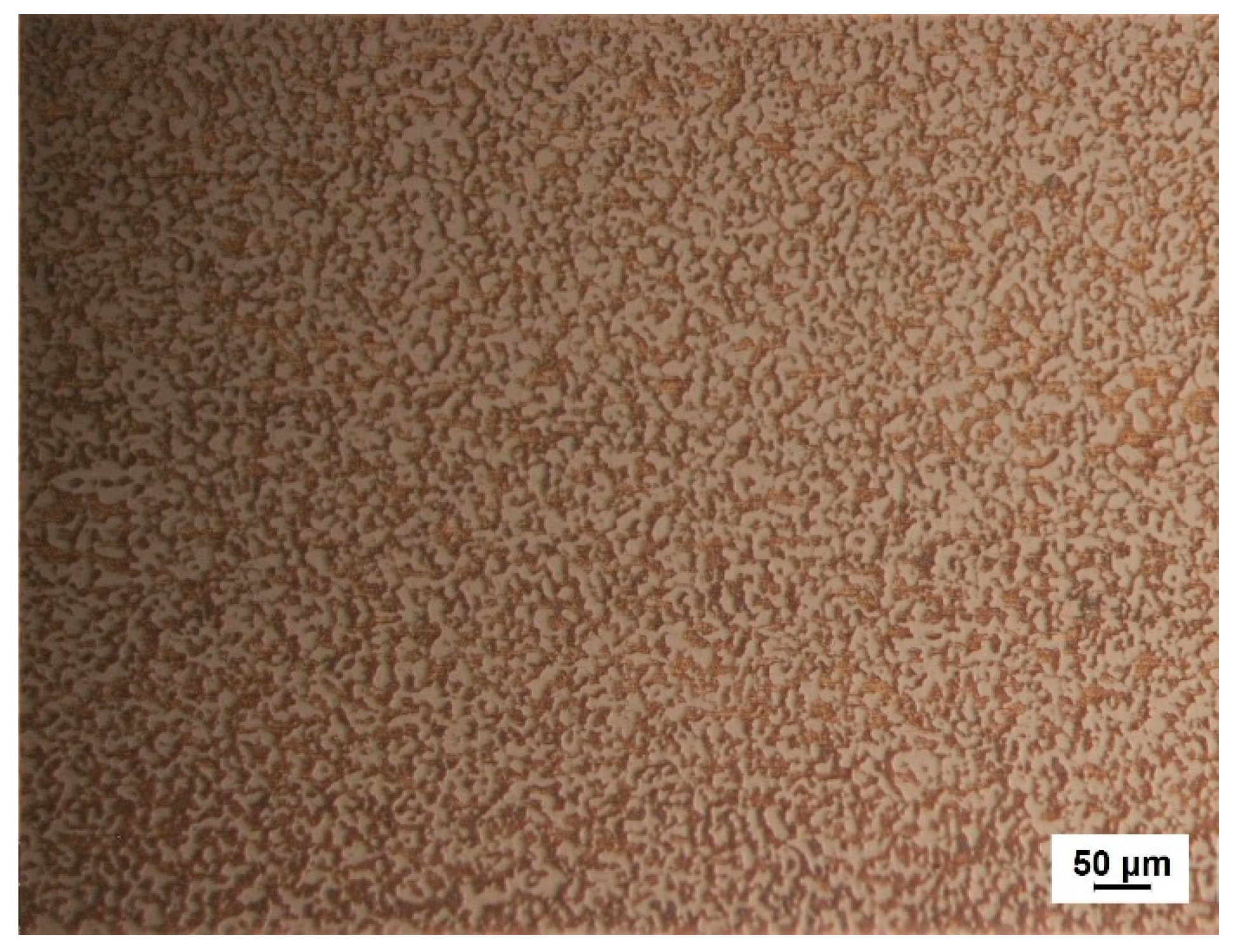

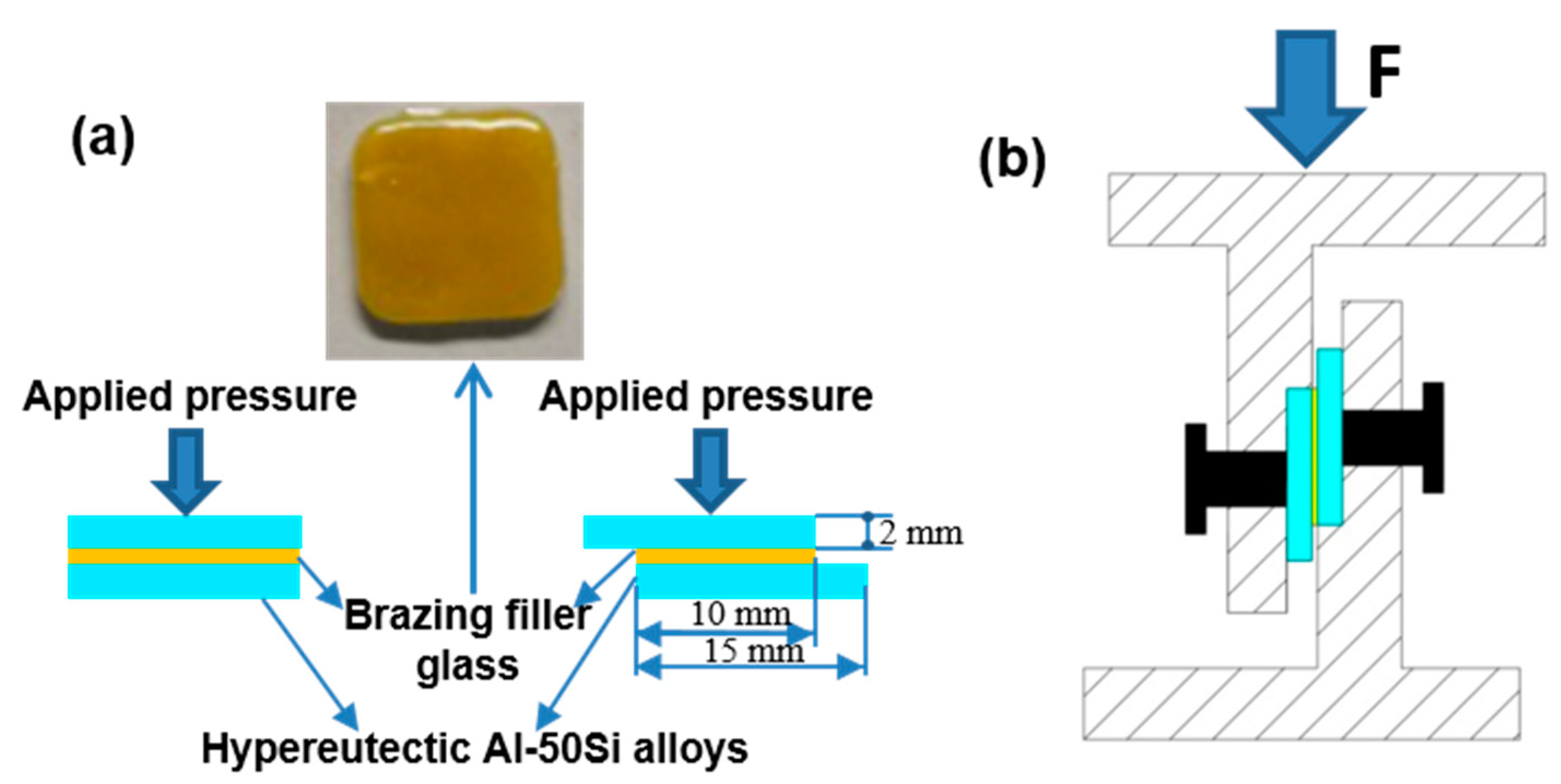

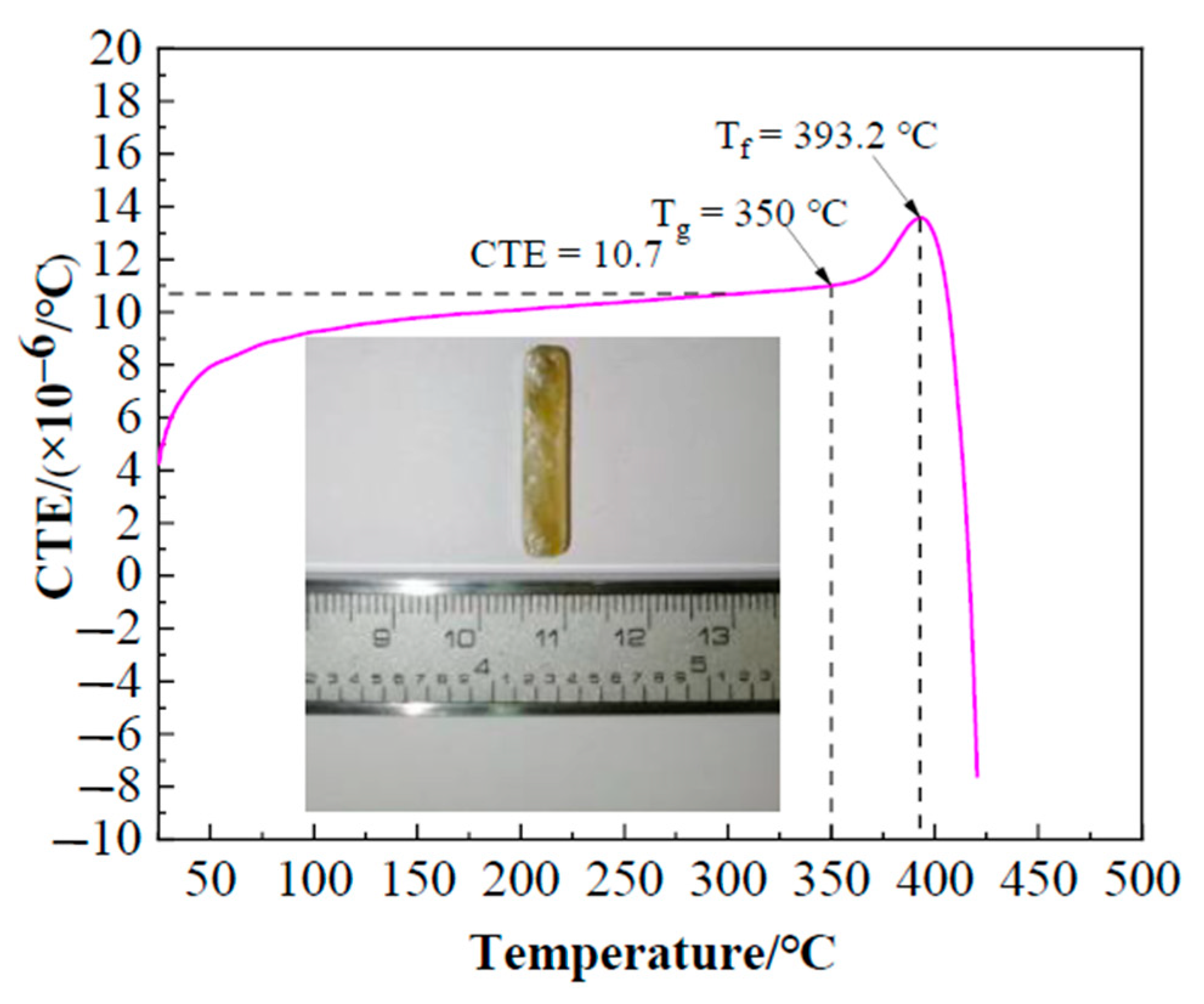
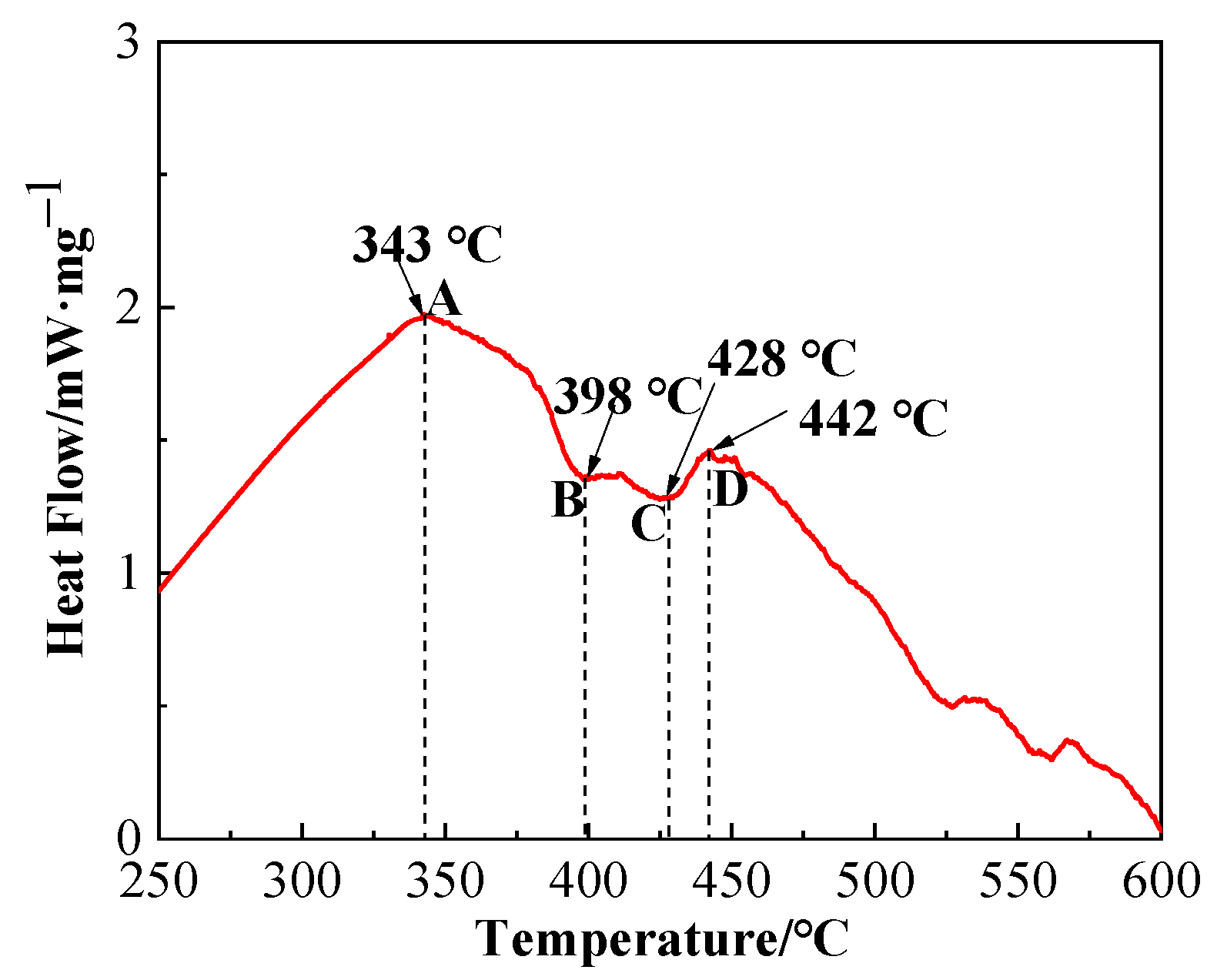
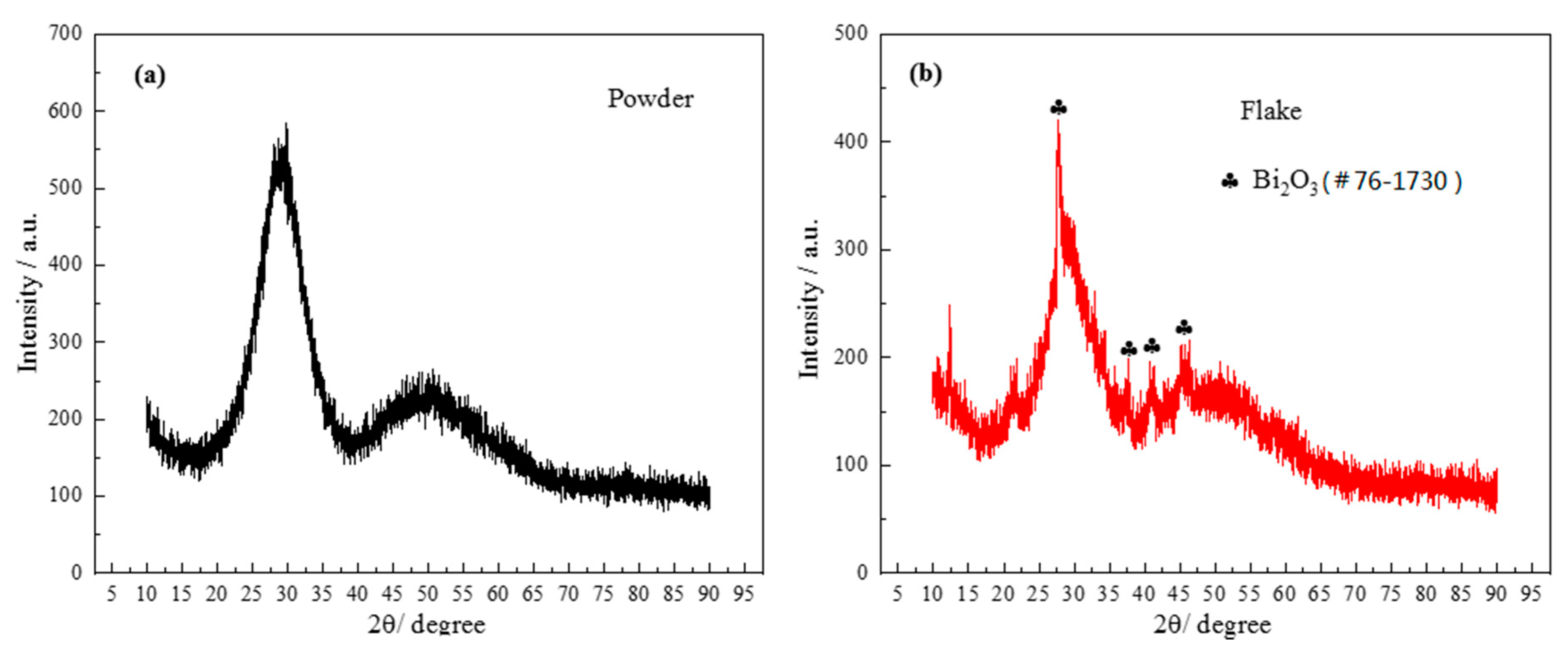

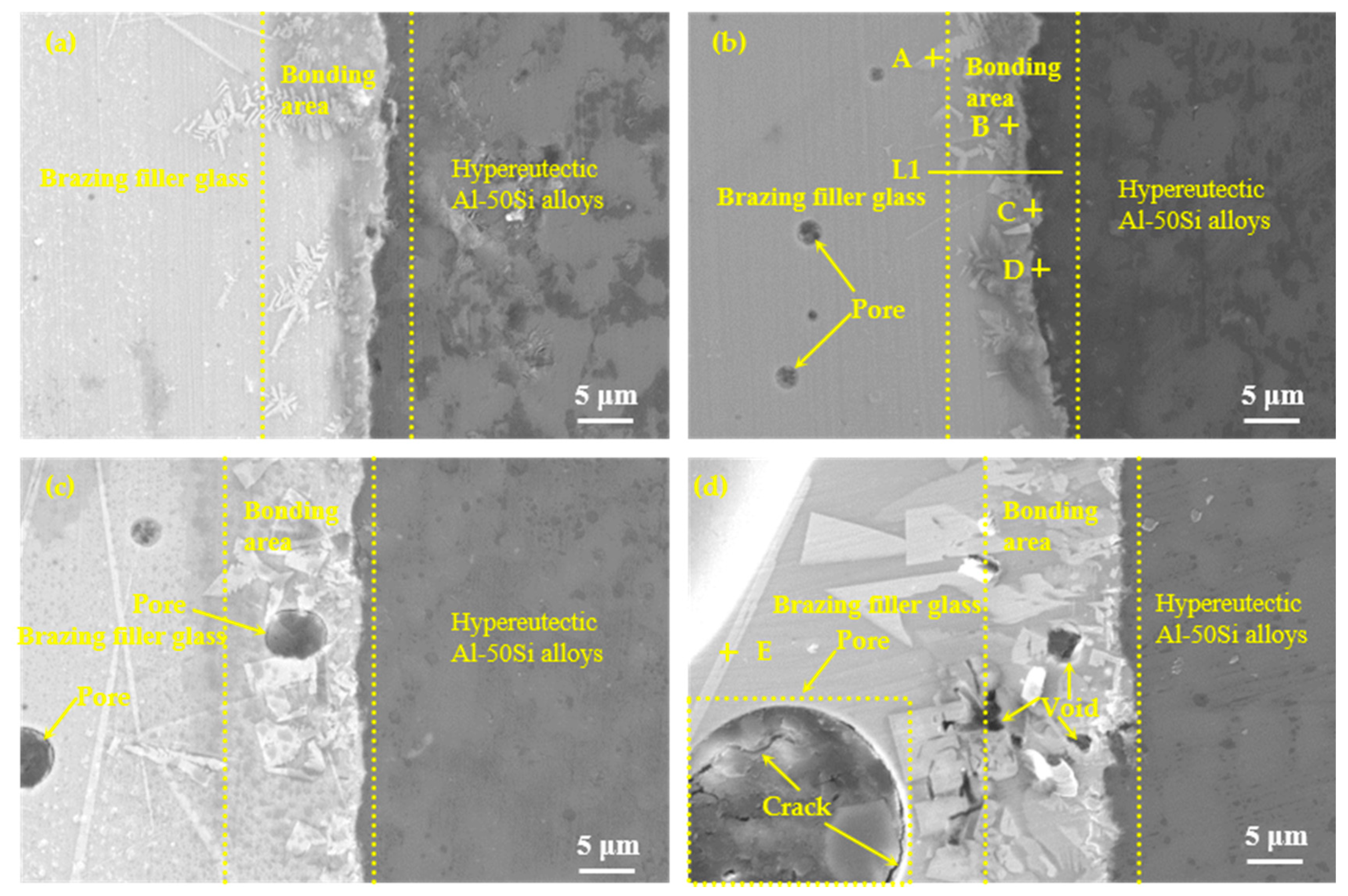
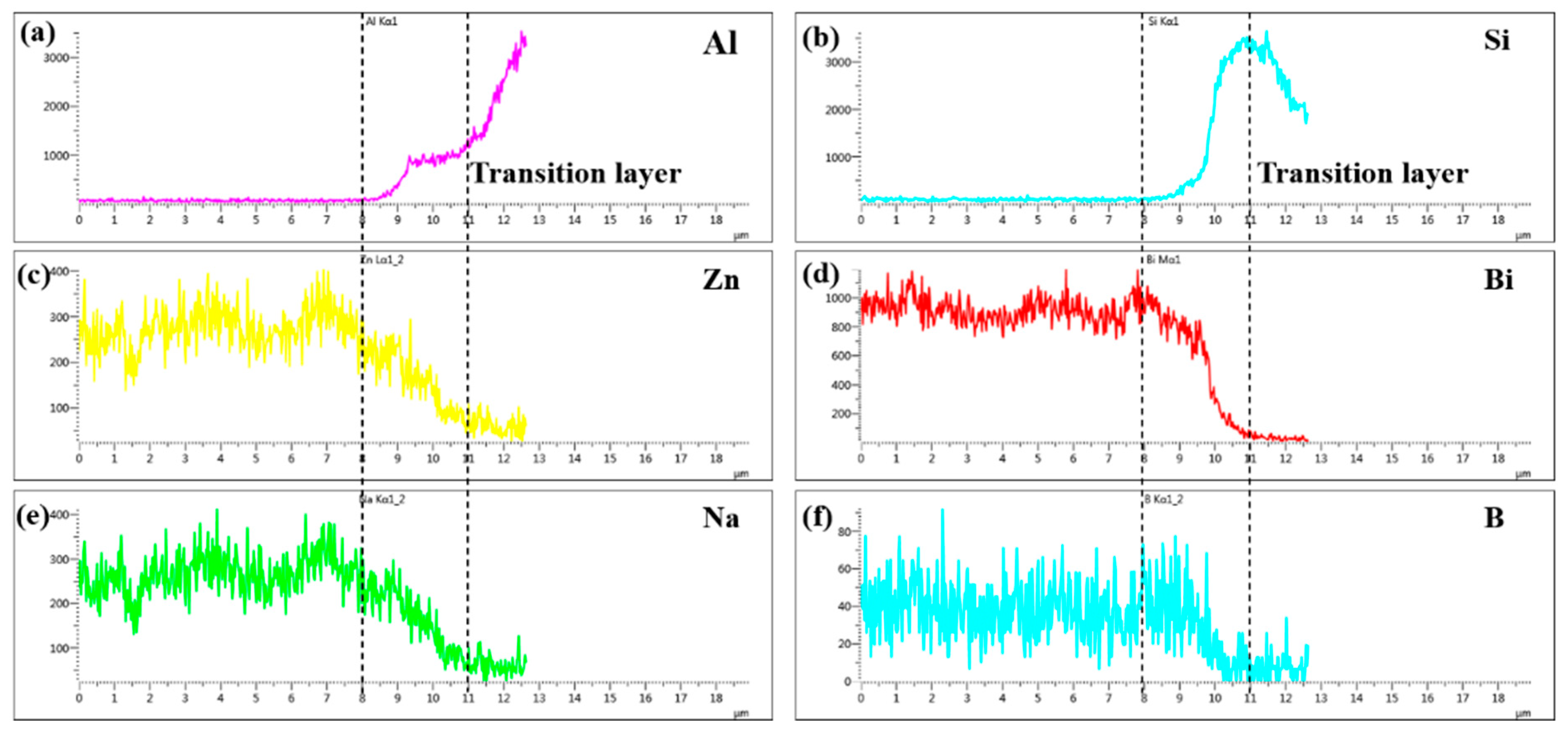


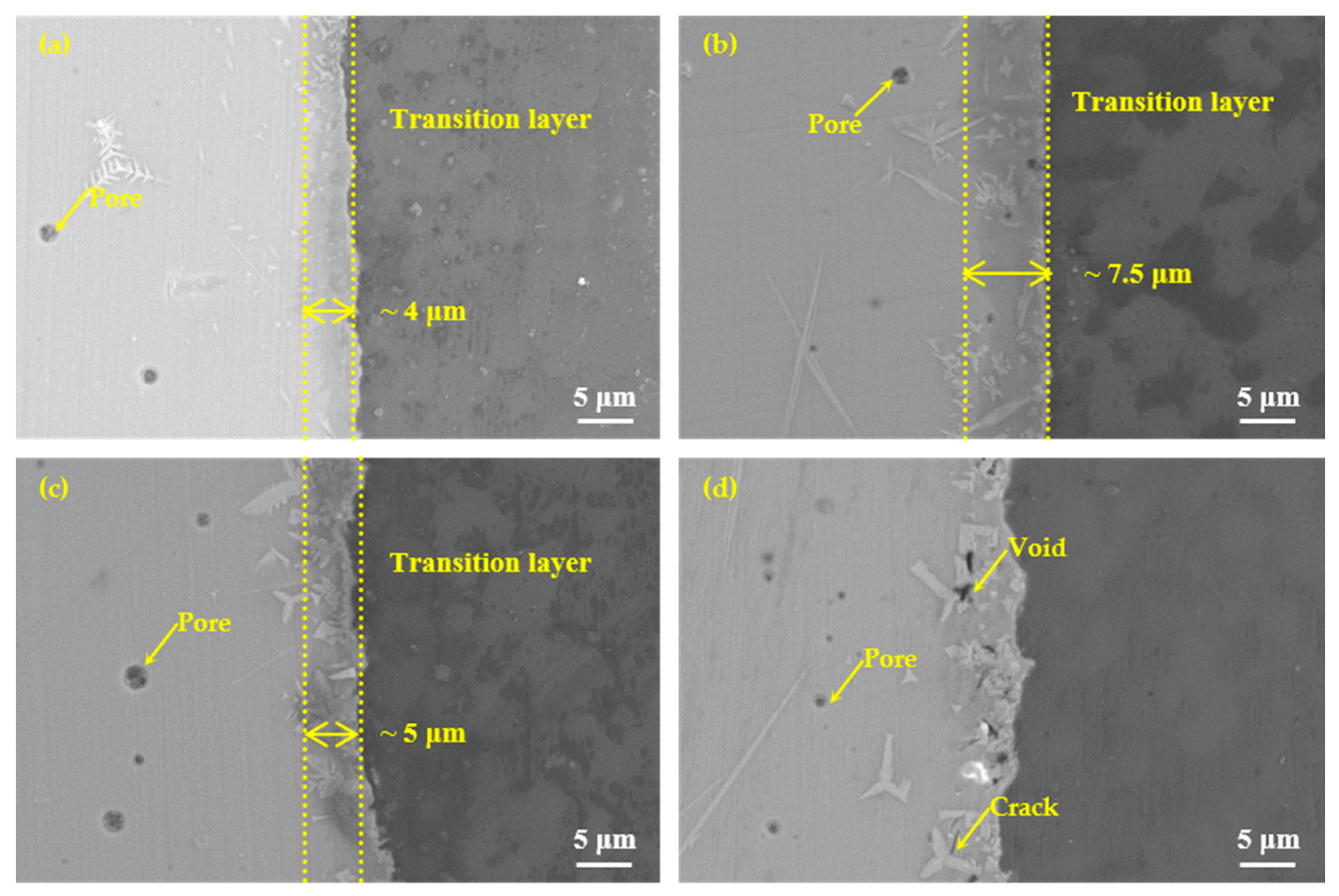
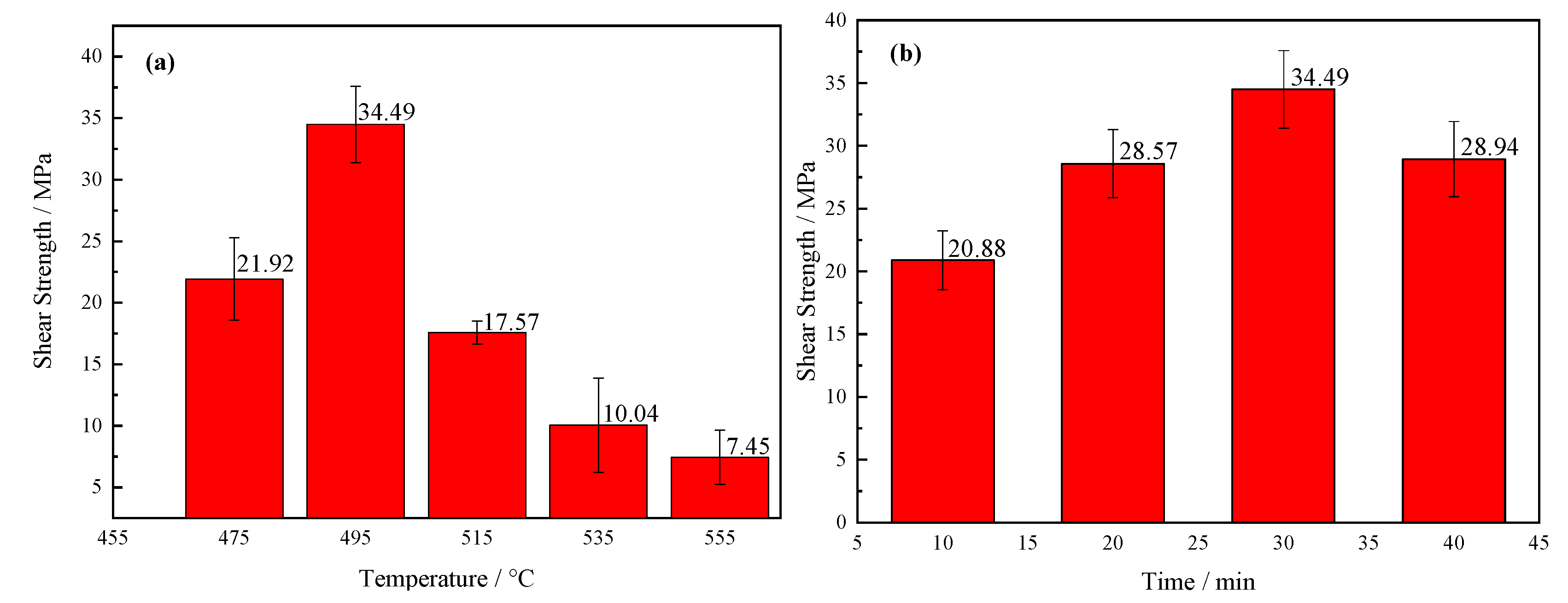
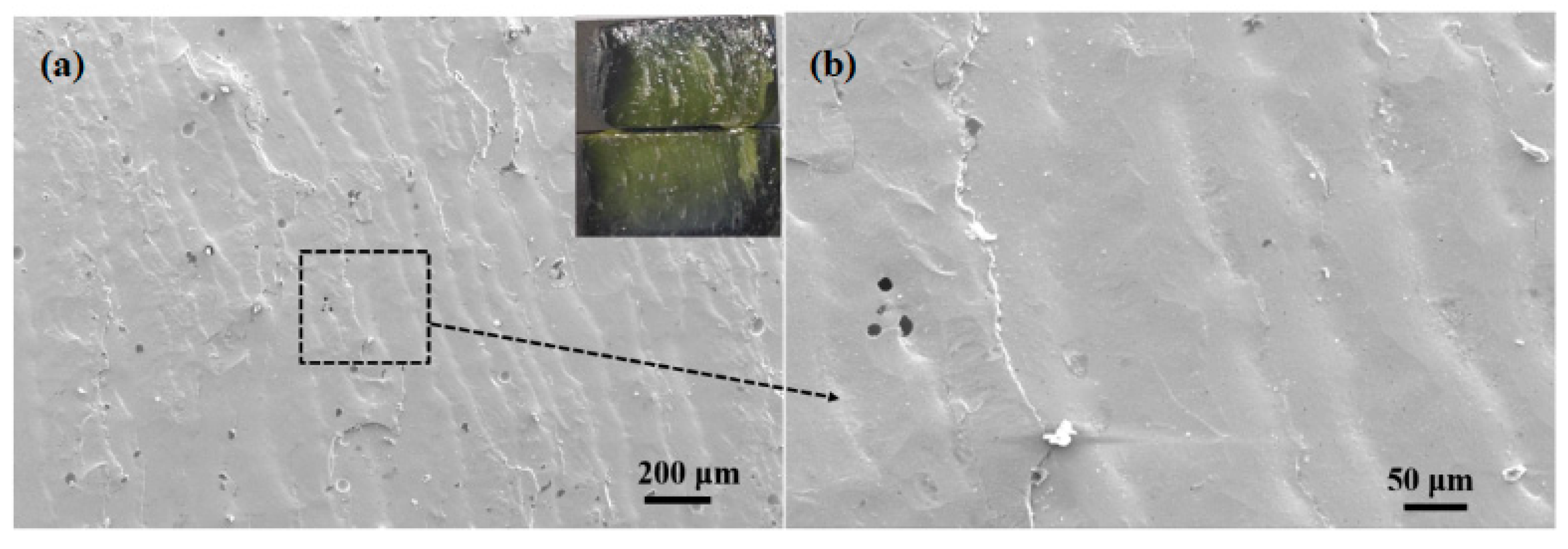
| Composition | Bi2O3 | ZnO | B2O3 | Na2CO3 | SiO2 |
|---|---|---|---|---|---|
| Content | 70–80 | 0–10 | 0–5 | 0–5 | 0–5 |
| Point | Temperature/°C | Description |
|---|---|---|
| A | 343 | Glass transition point |
| B | 398 | Glass softening point |
| C | 428 | Crystallization start temperature |
| D | 442 | Crystallization peak temperature |
| Point | Al | Si | Na | O | Bi | B | Zn |
|---|---|---|---|---|---|---|---|
| A | - | 0.7 | - | 9.4 | 84.2 | 5.0 | 0.7 |
| B | - | 0.7 | 2.3 | 15.7 | 61.0 | 9.0 | 11.3 |
| C | 2.5 | 15.1 | 2.1 | 13.8 | 46.8 | 11.9 | 7.8 |
| D | 15.1 | 45.1 | 0.4 | 14.2 | 1.4 | 23.1 | 0.7 |
| E | - | 0.3 | 1.0 | 13.7 | 72.7 | 8.1 | 4.2 |
| Temperatures/°C | 475 | 495 | 515 | 535 |
|---|---|---|---|---|
| Leakage rate/Pa m3/s | 8.0 × 10−9 | 1.0 × 10−10 | 6.2 × 10−8 | 5.6 × 10−7 |
| Times/min | 10 | 20 | 30 | 40 |
|---|---|---|---|---|
| Leakage rate/Pa m3/s | 1.2 × 10−9 | 3.8 × 10−10 | 1.0 × 10−10 | 3.4 × 10−9 |
Publisher’s Note: MDPI stays neutral with regard to jurisdictional claims in published maps and institutional affiliations. |
© 2020 by the authors. Licensee MDPI, Basel, Switzerland. This article is an open access article distributed under the terms and conditions of the Creative Commons Attribution (CC BY) license (http://creativecommons.org/licenses/by/4.0/).
Share and Cite
Wang, Z.; Gao, Z.; Ba, X.; Chu, J.; He, P.; Niu, J. Joining of Hypereutectic Al-50Si Alloys Using Lead-Free Brazing Filler Glass in Air. Materials 2020, 13, 5658. https://doi.org/10.3390/ma13245658
Wang Z, Gao Z, Ba X, Chu J, He P, Niu J. Joining of Hypereutectic Al-50Si Alloys Using Lead-Free Brazing Filler Glass in Air. Materials. 2020; 13(24):5658. https://doi.org/10.3390/ma13245658
Chicago/Turabian StyleWang, Zhenjiang, Zeng Gao, Xianli Ba, Junlong Chu, Peng He, and Jitai Niu. 2020. "Joining of Hypereutectic Al-50Si Alloys Using Lead-Free Brazing Filler Glass in Air" Materials 13, no. 24: 5658. https://doi.org/10.3390/ma13245658
APA StyleWang, Z., Gao, Z., Ba, X., Chu, J., He, P., & Niu, J. (2020). Joining of Hypereutectic Al-50Si Alloys Using Lead-Free Brazing Filler Glass in Air. Materials, 13(24), 5658. https://doi.org/10.3390/ma13245658




